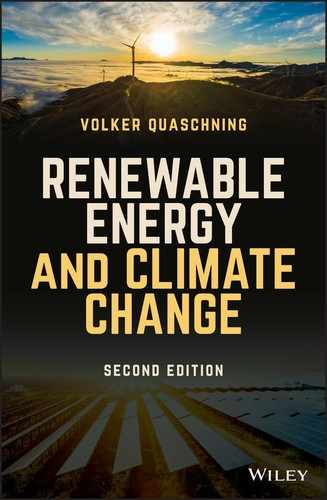CHAPTER 4
‘Energiewende’ (Energy Transition) – The Way to a Better Future?
Just like sauerkraut, kindergarten or autobahn, the term Energiewende has the potential to become firmly established in the English language. It was coined in 1980, when the Freiburg-based Öko-Institut published a report entitled ‘Energie-Wende: Growth and prosperity without oil and uranium’. At the time, however, the report met with a good deal of scepticism. The book was briefly reviewed in Die Zeit (weekly newspaper) and received the verdict ‘dubious’. The term Energiewende only made its breakthrough after the reactor accident at Fukushima, Japan, in March 2011, which led to the German government's reversal of a previous decision to extend the operating life of German nuclear power plants and an announcement of a turnaround in energy policy.
It is true that the energy transition is closely linked to the nuclear phase-out. But the energy transition is not really completed until we have achieved a climate-friendly energy supply. The climate can only be saved if, in the medium term, all countries on Earth reduce their greenhouse gas emissions to almost zero. However, there are many among us who just cannot, or do not want to, imagine life without oil, natural gas and coal.
Yet, a mere 300 years ago, renewables made up the Earth's entire energy supply. It is quite certain that the world's energy supply will once again be completely carbon-free 200 years from now. By then the last deposits of fossil energy sources will have been exhausted. As a result of an almost 500-year history of fossil energy use, the climate would have totally collapsed by then. If we want to prevent this happening, we must convert to carbon-free energy supplies long before then. We only have about 30 years left to achieve this (Figure 4.1). It is therefore in the hands of our generation to either preserve or massively endanger the livelihoods of future generations.
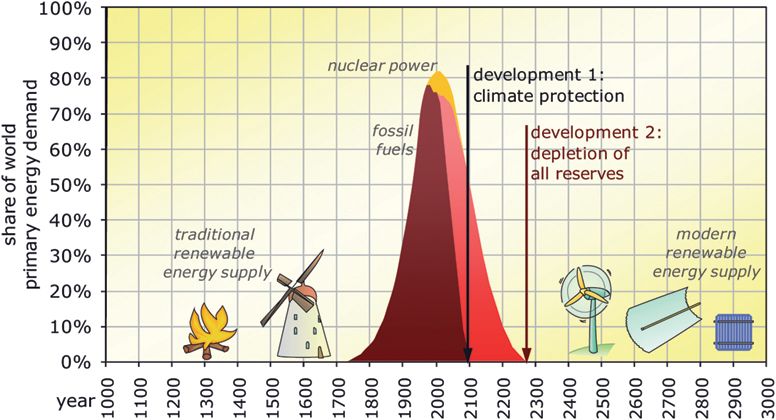
Figure 4.1 The energy transition won't be completed until we have established an energy supply system entirely without nuclear and fossil fuels. There are two scenarios for this: We can wait until energy supplies run out, or we can practise genuine climate protection.
4.1 Coal and Nuclear Power Plants – Crutch Instead of Bridge
A rapid energy transition is not easy to achieve, but this is not because it would be technically or economically impossible. Rather, the problem lies with numerous players who benefit greatly from today's energy supply structure and are among the losers in a rapid turnaround. Until a few years ago, many players who were supposed to implement the energy transition today, generally questioned its feasibility. Now, politicians and companies transformed from Saul to Paul are supposed to lead the most important project of our century for humankind's continued success on Earth. A healthy scepticism may be appropriate. Without people who maintain the necessary pressure, a quick turnaround is unlikely to succeed. Coal and nuclear power plants in particular, which are often referred to as bridges for the renewable energy age, are increasingly becoming a brake block, because their existence is increasingly hindering the rapid expansion of renewables.
4.1.1 Energy and Automotive Companies Have Bet on the Wrong Horse
Four major energy companies E.ON, RWE, EnBW, and Vattenfall controlled around 80% of the German electricity market for many years. In 2000 these companies had already agreed with the then ‘red/green’ federal government to phase out nuclear power. They obviously didn't take that agreement too seriously. True to the motto ‘After red/green comes conservative/liberal and then we reverse everything’, they worked behind the scenes to extend the operating life of German nuclear power plants and planned and built several new coal-fired power plants. In autumn 2010, this strategy was going to plan, with the extension of the operating lives of German nuclear power plants decided by the then conservative/liberal government, until Fukushima put a firm stop to it.
 The Last Dinosaur
The Last Dinosaur
This was the title of an award-winning report in Die Zeit (weekly newspaper) about Jürgen Großmann, the former CEO of RWE AG. From 2007 to mid-2012. He headed the fortunes of Germany's second-largest energy company. Since he was regarded as the driving force behind the decision to extend the operating lives of German nuclear power plants in 2010, he received the ‘Dinosaur of the Year’ anti-award from the Nature and Biodiversity Conservation Union. As the figurehead of the German energy industry, he is symptomatic of the relationship between corporations and renewables, climate protection and coal and nuclear power plants with the following quotations:
- 12 July 2009: ‘Germany is switching from coal to gas in order to be ecologically cleaner. … This is no way to protect the global climate’.
- 31 October 2009: ‘Identical reactors are running in the Netherlands, France or Belgium for 60 years or more, in the USA there is even talk of 80 years. … With the current time limit of 32 years we remain below our economic possibilities’.
- 20 January 2010 ‘Imagine, 80% of our electricity generation depended on renewables: It's not just the lights that would go out in times like these’.
- 20 April 2011: ‘Lignite is the German oil – this old RWE slogan applies in today's uncertain times more than ever’.
- 18 January 2012: The promotion of solar energy in Germany makes as much sense as ‘cultivating pineapples in Alaska’.
Jürgen Großmann was replaced on 1 July 2012. In the meantime, the large German energy companies have restructured considerably. The language has become much more moderate. Business with fossil and nuclear power plants was partly outsourced to separate companies, and renewables are now officially very popular. Nevertheless, the large and climate-damaging power plants are still owned by the energy companies or the outsourced companies.
This corporate policy has wasted valuable years that could have been used to implement the energy transition. Despite the nuclear phase-out and climate protection promises, many energy companies and municipal utilities today still have a power plant fleet that is completely inappropriate for the energy transition. In 2012 RWE commissioned two new lignite-fired power plant units at Neurath, with an output of 2200 MW. Vattenfall's 1700-MW Moorburg coal-fired power plant in Hamburg was not finally connected to the grid until 2014. If these billion-euro investments are to pay off, the rapid phasing out of coal, which is urgently needed for climate protection, is practically impossible. This also explains why the expansion of photovoltaic (PV) and wind power plants in Germany has been significantly reduced in recent years and why Germany has virtually lost its pioneering role in the energy transition and in climate protection.
If nuclear and coal-fired power plants are to be quickly replaced by solar and wind power plants, they must be written off prematurely. This threatens companies with massive losses, which in extreme cases can even threaten their very existence (Figure 4.2).
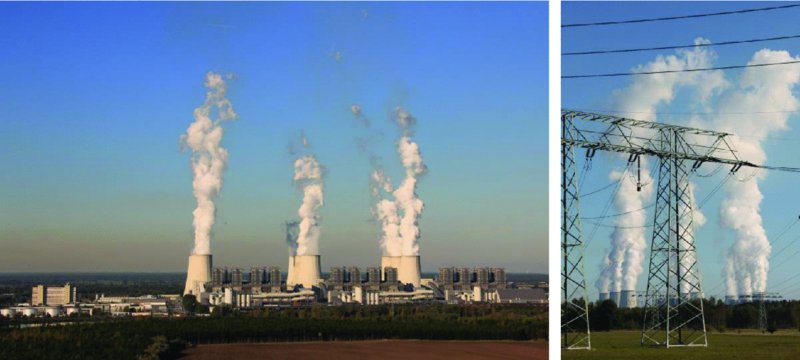
Figure 4.2 Lignite-fired power plant Jänschwalde near Cottbus. The energy companies have the wrong power plant fleet for a quick energy transition.
Other industries are also blocking a rapid energy transition with undesirable technological developments. In the transport sector, for example, the energy transition can only succeed if the majority of vehicles are converted from internal combustion engines to efficient electric motors. The efficiency of electric motors is significantly higher than that of petrol or diesel engines, and the electricity can be generated without carbon dioxide emissions, using renewable power plants. What sounds like a look into a distant future today was already reality 100 years ago: About 40% of all cars in New York were electric at the time. At that time, the tedious cranking of petrol engines made them particularly unattractive. It was not until the invention of the starter motor in 1911 that the triumphant advance of internal combustion engines began. Today, car manufacturers find it difficult to break with a tradition that is more than 100 years old and to bring modern electrical versions onto the market. Instead, they are intensively lobbying to delay stricter carbon dioxide limits and thus prolong the age of fossil engines. There may also be simple economic reasons to continue to apply the brakes: electric cars do not need oil changes and are less susceptible to wear. This is to the detriment of the attractive spare parts business and the workshops associated with repairs. In addition, batteries represent a major proportion of the value of electric cars. They have to be purchased from third parties and therefore do not make a significant contribution to the company's own added value. Finally, the main argument comes from the customers: despite climate change and rising fuel prices, less efficient but powerful cars continue to be trendy.
4.1.2 Lignite – A Climate Killer Made in Germany
Lignite-based power generation is one of the most climate-damaging forms of power generation. In 2016, Germany was the world's number one lignite producer, ahead of China.
Old lignite-fired power plants generate up to three times as much carbon dioxide as modern gas-fired power plants. Representatives of the electricity industry like to cite efficiency increases in the power plant sector as an important milestone towards effective climate protection. Indeed, enormous quantities of carbon dioxide can be saved if ailing, inefficient power plants are replaced with ultra-modern ones. Whereas old lignite-fired plants usually reached an efficiency of less than 40% in electricity production, new plants can easily reach 43%. Technically, efficiencies of 48–50% are possible.
For example, with an efficiency of around 35%, the Jänschwalde power plant near Cottbus in Germany is one the oldest and most inefficient large power plants in eastern Germany (Figure 4.3). With carbon dioxide emissions amounting to around 23.7 million tons in 2015, this plant alone produces about 3% of all carbon dioxide emissions caused by energy use in Germany.
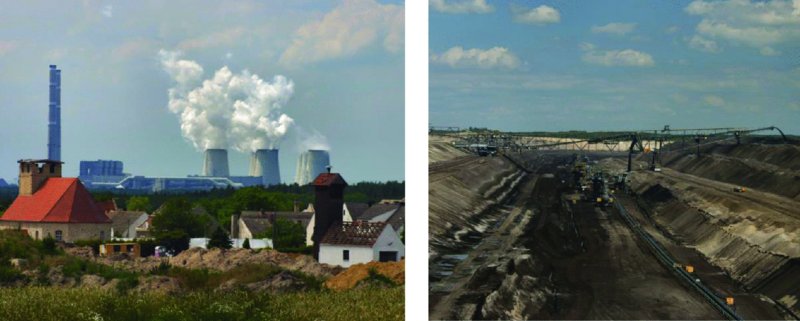
Figure 4.3 Left: The village of Horno had to give way to opencast lignite mining in 2005. Right: After the coal has been mined, a ‘lunar’ landscape remains.
An example of the potential for increasing efficiency is the new BoA 2/3 Neurath dual power plant unit on the outskirts of Grevenbroich, Germany. BoA stands for ‘Braunkohlekraftwerk mit optimierter Anlagentechnik’ (lignite-fired power plant with optimized plant technology). The 2.6 billion euro plant with an efficiency of over 43% was commissioned in 2012, thereby saving around 6 million tons of carbon dioxide per year. The main problem, however, is that the power plant will continue to emit around 14 million tons of carbon dioxide every year. As an example, this is far higher than the total carbon dioxide emissions caused by the 40 million people in Kenya. With an average lifetime of 40 years, even a large, efficient power plant quickly develops into an obstacle to progress when it comes to effective climate protection. By the time the Neurath power plant is supposed to be disconnected from the grid in 2050, industrialized countries like Germany should have reduced their carbon dioxide emissions to zero. This is a level that not even the most efficient power plants can achieve.
The climate-damaging nature of lignite-fired power plants is not the only problem. They also release enormous amounts of toxic pollutants such as mercury, arsenic, or nitrogen oxides, thereby causing many health problems, including death. Enormous interference with nature and the landscape already occurs during opencast mining. Pumping off huge quantities of groundwater upsets the entire water balance of the region. After coal mining, a ‘lunar’ landscape remains (Figure 4.3), which requires considerable effort to renaturalize into a lakeland area (Figure 4.4).
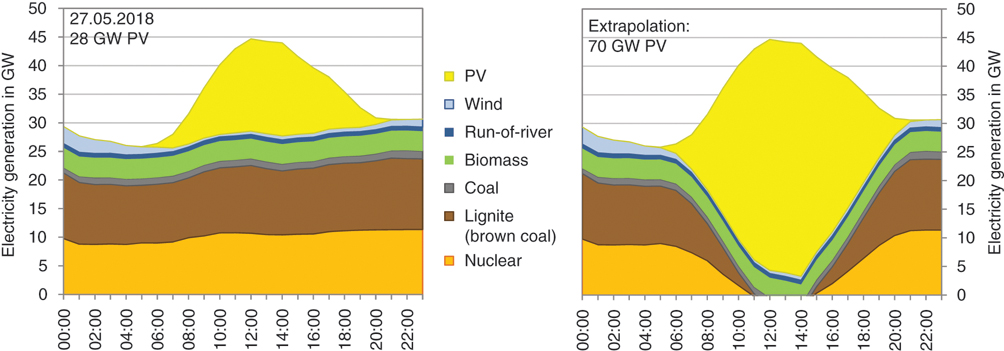
Figure 4.4 Left: Electricity generation from PV & wind power plants and generating units larger than 100 MW on 27 May 2012 in Germany with an installed PV capacity of 28 GW. Right: Same day with extrapolation to an installed PV capacity of 70 GW.
Data: EEX Transparency.
Another problem with coal-fired power plants is that they are relatively difficult to regulate. Lignite-fired plants are usually designed for a base load. This means they work optimally when they deliver constant output for long periods of time. However, due to the increased use of wind power and solar energy plants, power fluctuations are increasing in the grid, and the demand for base-load power plants is decreasing accordingly.
To a small extent, lignite-fired power plants can compensate for power fluctuations. Reducing the output to 50% of the capacity is possible with new systems. However, this will not be enough for a rapid expansion of renewables. In spring 2012 there were already days when PV alone accounted for around 40% of the electricity supply in Germany at noon. On these days, PV already covered the entire midday peak. If the installed PV capacity continues to increase, it will increasingly replace base-load power plants. With an installed capacity of 70 GW, PV could cover almost the entire electricity demand at noon on individual days. This would then present the existing base-load power plants with almost unsolvable problems as once such plants have been taken off the grid, it takes hours for them to deliver their full power again. Reason enough for the energy suppliers and sympathetic politicians to demand a slower expansion of renewables in Germany and to throw all climate protection ambitions overboard.
4.1.3 Carbon Dioxide Sequestration – Out of Sight, Out of Mind
Since even a medium-term increase in efficiency in fossil power plants does not offer an alternative to the supply of climate-compatible energy, supporters of fossil energy plants have looked for arguments and ways to avoid coming under even more fire because of the damage caused to the climate.
Carbon dioxide sequestration is suggested as a way out of the dilemma. The idea behind it is simple and at first glance also appears highly plausible. The idea is that power plants of the future will no longer emit the carbon dioxide from burning coal and natural gas into the atmosphere, but instead capture and store it in a safe place (Figure 4.5).
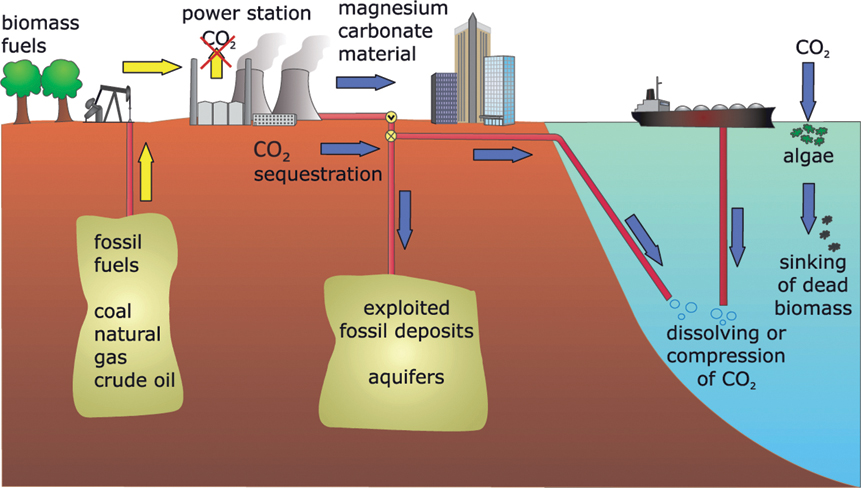
Figure 4.5 Options for final storage of separated carbon dioxide.
The following options for the safe disposal of carbon dioxide are promising:
- manufacture of carbon-based building materials for the construction material industry;
- end-storage underground in depleted fossil deposits, in aquifers and in salt beds;
- compression or dissolution in the ocean; and
- bonding with special algae in the ocean.
However, a critical examination of the options available produces strong doubts about this method of carbon dioxide disposal. The technology for sequestration and storage is still at the research stage. When testing individual methods such as binding by algae in the sea, there have been severe setbacks which fundamentally call their suitability into question. Controversy also surrounds end-storage in the ocean. It is possible that the carbon dioxide will escape again into the atmosphere after a short period or will have an extreme but not yet identifiable effect on the ecological system of the oceans.
Underground storage locations are not available everywhere or would quickly be exhausted. If all power plants in the world were required to dispose of their carbon dioxide in a way that would not damage the climate, it would take an enormous logistical effort to transport the carbon dioxide over what could sometimes be thousands of kilometres to end-storage depositories. In addition, critics are concerned about risks from such deposits. If carbon dioxide were to escape uncontrolled in large concentrations, it could lead to death by suffocation of nearby humans and animals. In addition, numerous underground storage facilities are to be used for the storage of gas from renewables (cf. Chapter 13). If they were to be filled with carbon dioxide, they would no longer be available for renewables-related storage.
 Carbon Dioxide-Free Coal-Fired Power Plants – Not Really Free of Carbon Dioxide
Carbon Dioxide-Free Coal-Fired Power Plants – Not Really Free of Carbon Dioxide
With the development of technologies for the sequestration and storage of carbon dioxide, grandiose claims were made that power plants will one day be carbon dioxide-free. Strictly speaking, however, even carbon dioxide retention techniques can never make a fossil power plant free of carbon dioxide. The burning of fossil energy sources in these power plants inevitably produces carbon dioxide. So-called CO2-free fossil power plants only separate carbon dioxide from other combustion gases so that it can be stored ultimately in a concentrated form outside the atmosphere. Carbon dioxide also escapes inadvertently during fuel processing, sequestration, and storage. In the long term up to 10% of carbon dioxide, and in individual cases even more, reaches the atmosphere again.
The term ‘carbon dioxide-free coal-fired power plant’ is therefore misleading. A company in the solar sector actually sued an energy supply company for misrepresentation over its claims that CO2-free power plants were being built in Germany. The court ruled in favour of the solar company. Whether or not fossil power plants with carbon dioxide separation are carbon dioxide-free in legal terms is likely to be examined by other authorities.
It will be several years until proven technologies for capture and storage of carbon dioxide are available for commercial installations. Currently only studies and prototype facilities exist. Commercial introduction is envisaged for the year 2020 [Vat06]. Since the construction of final storage facilities for carbon dioxide in Germany has met with similar ‘acceptance’ as final storage facilities for nuclear waste, it remains questionable whether such facilities will even be built there. In addition, existing power plants can only be retrofitted at great expense, if at all. From today's perspective, carbon dioxide sequestration therefore appears more like a questionable attempt to legitimize climate-damaging fossil power plants.
Probably, the most important argument against global sequestration of carbon dioxide is the economic viability of doing so. Carbon dioxide sequestration generally reduces the efficiency of a power plant. Added to this is the cost of the transport and end storage of the carbon dioxide. It is difficult at present to estimate the exact cost involved. Many estimates predict that the cost increases for electricity from fossil power plants would be up to double present values [IPC05]. For many countries in the world this would rule out even the possibility of carbon dioxide sequestration. In contrast, cost estimates for renewable power plants show that in many locations they would prove to be more economical than fossil power plants within a relatively short period – regardless of whether or not they have carbon dioxide sequestration.
But perhaps in the future we will have to rely on carbon capture technology after all, in order to manage the consequences of climate change. Carbon dioxide could be absorbed through cultivation of biomass in the form of energy crops. If the biomass is then burned in power plants and the resulting carbon dioxide is separated and stored outside the atmosphere, it could even be possible to reduce the carbon dioxide content of the atmosphere again. However, it would make much more sense and be considerably cheaper to completely avoid the further increase in carbon dioxide concentrations through the use of renewables.
![]()
| Background information on CO2 capture and storage |
4.1.4 Nuclear Power Comeback Was Not a Radiant Success
Almost every discussion on climate change ends up looking at nuclear energy as a possible saviour, despite the fact that its contribution to climate protection has always been small. However, after the nuclear accident at Fukushima, nuclear energy no longer seems to be an option for the majority, at least in Germany. The arguments against nuclear energy have already been explained in detail in previous chapters of this book. Even if the widely differing assessments of risks are ignored, nuclear energy does not offer an option for effective climate protection. The main reasons for this are:
- Nuclear energy only accounts for just under 5% of the world's primary energy supply, in Germany just over 6% in 2017, with a downward trend. In terms of final energy consumption, the proportion is even lower. Nuclear energy is therefore relatively insignificant for our energy supply.
- Electricity from new nuclear power plants is considerably more expensive than electricity from new solar and wind power plants.
- The amount of uranium that can be extracted economically is very limited. The price of uranium has already increased significantly in recent years.
- The output of nuclear power plants is only adjustable to a limited extent, which means they are not suitable for electricity supply systems with a high proportion of wind and solar power plants, whose output fluctuates by their very nature.
- Nuclear energy produces carbon dioxide only indirectly, e.g. during uranium mining. Greenhouse gas emissions are therefore considerably lower than with fossil power plants. However, nuclear energy carries other extremely high risks such as nuclear accidents, nuclear military conflicts or terrorist attacks.
- Plus, the thorny problem of permanent disposal of high-level radioactive waste has still not been resolved.
- The civilian use of nuclear energy also increases the risk of nuclear armed conflict through proliferation of uranium enrichment and nuclear fission technologies.
- Nuclear fusion will not be ready for use for several decades and thus too late to save the climate; it is also difficult to control and is extremely expensive.
 U-Turn Followed by U-Turn
U-Turn Followed by U-Turn
On 14 June 2000, the ‘red/green’ federal government and the energy supply companies in Germany agreed for the first time to phase out nuclear energy. There was no fixed exit date. For all plants, residual electricity quantities were agreed that would probably have been reached in 2022.
On 28 October 2010, the conservative/liberal federal government decided to extend the operating lives of nuclear power plants by up to 14 years – a kind of ‘exit from the nuclear exit’.
Due to pressure relating to the events of the reactor accident at Fukushima, on 6 June 2011 the conservative/liberal government decided to reinstate the decision to phase out nuclear power. Eight nuclear power plants were shut down immediately. For the others, fixed decommissioning dates apply. The last nuclear power plant is now scheduled to be shut down at the end of 2022. But once again, there are some voices from business and politics that want to reconsider this decision. To be continued?
Germany is not the first country to withdraw from the use of nuclear energy. Belgium and Switzerland have also decided to phase out nuclear power, but this will be completed later than in Germany. Italy shut down its four nuclear power plants as early as 1986. In a referendum in 2011, 94.1% rejected a comeback of nuclear energy. A referendum in 1978 also prevented the commissioning of the Zwentendorf nuclear power plant in Austria. The use of nuclear energy and the construction of nuclear reactors are now prohibited in Austria by a constitutional law.
4.2 Efficiency and CHP – A Good Double for Starters
4.2.1 Combined Heat and Power – Using Fuel Twice
When it comes to increasing efficiency, combined heat and power (CHP) is often promoted as a promising candidate. In conventional steam turbine power plants that burn lignite or hard coal, electricity is generated with an efficiency between 35% and 45%. Modern gas and steam turbine power plants, also referred to as combined-cycle gas turbine plants (CCGT), which use natural gas, can achieve up to 60%. However, this means that at least 40% of the primary energy is wasted through the cooling tower of the power plant.
CHP, or cogeneration, plants utilize the heat from electricity generation and are able to exploit up to 90% of the fuel. As a result, a well-designed plant produces less carbon dioxide than when electricity and heat are generated separately.
Many comparisons of CHP plants with plants that generate heat and electricity separately using fossil fuels show possible carbon dioxide savings of up to 50%. However, these comparisons usually pit modern CHP plants against antiquated electricity plants. If the comparison is made on a like-for-like basis, the carbon dioxide savings are reduced to a meagre 15–20% (Figure 4.6) – too little to save the climate. Furthermore, these savings are only possible with optimal CHP plant operation. For example, in summer when a cogeneration plant is only supposed to generate electricity but not heat, it will have great difficulty in even coming close to the dream efficiency of 90%. A cogeneration plant can sometimes end up producing even more carbon dioxide than a straightforward electricity power plant.

Figure 4.6 Comparison of primary energy demand and CO2 emissions between CHP and separate generation of heat and electricity in modern plants.
If, on the other hand, sufficient heat demand exists over the entire year, cogeneration plants can help to reduce carbon dioxide. However, with CHP plants that use fossil fuels the savings for effective climate protection are too low. On the other hand, CHP plants that use energy sources such as biomass, renewably produced hydrogen, renewably produced methane or geothermal energy, are carbon-neutral and can accelerate the switch to a carbon-free energy supply.
4.2.2 Saving Energy – Achieving More with Less
As the previous chapter showed, the options for saving energy are enormous – at least in industrialized countries like Germany. The situation is different in developing countries. Someone who does not even own an electric light bulb and lives in a house without heating will be in no position to save energy through energy-saving bulbs or building insulation. Figure 4.7 shows that per capita energy requirements generally increase with the per capita gross domestic product (GDP), which roughly mirrors the prosperity of a country.

Figure 4.7 Per capita primary energy consumption based on gross domestic product (GDP) according to the purchasing power parity method (PPP) for different countries.
Data: [IEA17], 2015.
The differences between countries with the same GDP per inhabitant are considerable. Whereas the GDP per inhabitant in Canada and in Denmark is almost identical, a Canadian consumes far more than double the primary energy of someone living in Denmark. In addition to the way people live and how they handle energy, the climate conditions and industrial structure of a country also play an important role in energy consumption. However, having high energy needs does not automatically equate to high greenhouse gas emissions. Although the per capita energy requirement of Iceland is clearly higher than that of Canada, its carbon dioxide emissions are substantially lower. This is due to the fact that Iceland meets most of its energy requirements carbon-free, using hydropower and the natural heat of the Earth.
Many countries in the world have a low level of prosperity and, consequently, a low demand for energy. Once the per capita energy requirements of China and India reach the same levels as Great Britain or Germany, this alone will more than double global demand. Considering the high growth rates of both countries, this would seem to be only a matter of time. If, in the interim, the industrialized countries were to halve their energy needs and the developing countries follow their example, this would considerably slow down the rise in energy demand.
Along with the growing per capita energy requirements in developing and emerging countries, the continuous rise in the world's population is also adding to the steady increase in energy demand. Between 1960 and 2000 the world population doubled, and energy requirements tripled (Figure 4.8). If the world population continues to climb at this rate and reaches nine billion by 2050, this alone will mean a 50% increase in energy demand – even without any increase in per capita energy requirements.
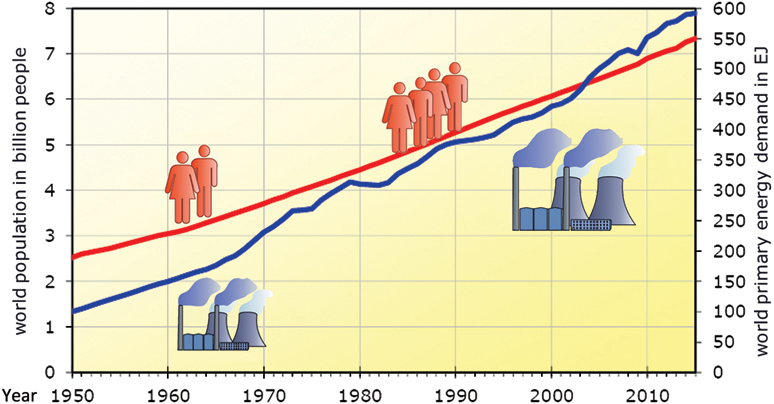
Figure 4.8 Development of worldwide primary energy demand and increase in world population.
These facts clearly show that energy-saving measures are enormously important in at least putting a brake on the increasing demand for energy worldwide. However, these measures alone will not be enough to achieve a major reduction in worldwide greenhouse gas emissions over the next 50 years. Along with implementing every conceivable measure to save energy, the most important thing will be to ensure that those energy requirements that cannot be eliminated are at least carbon-free. There is also a comprehensive solution to this: renewables.
4.3 Renewables – Energy Without End
The options for supplying climate-compatible energy discussed above offer only limited possibilities for reducing carbon dioxide. The situation is totally different with renewable energy sources: these offer almost unlimited potential.
Each year the sun radiates 1.5 quintillion kilowatt hours of energy towards the Earth. The atmosphere swallows up around 30% of this energy but over one quintillion kilowatt hours are still able to reach the Earth's surface. Our current primary energy needs are around 170 trillion kilowatt hours worldwide. By the way, a quintillion is a 1 with 18 zeros, and a trillion has 12 zeros. Therefore, the amount of energy that reaches the Earth's surface from the sun each year is 6000 times more than the total primary energy requirement of the world. So, we only need to use about one hour's worth of the solar energy that reaches the Earth's surface in order to cover the energy needs of the whole of mankind for a whole year.
Natural processes convert some of the sun's energy into other renewable forms of energy, such as wind, biomass, and hydropower. In addition to these energy forms, we are also able to use the natural heat of the Earth as well as tidal power derived from the motion of the moon in conjunction with other planets. All sources of renewable energy combined exceed the total fossil and nuclear fuels available on Earth many times over (Figure 4.9). In less than one day the sun radiates more energy to the Earth's surface than we could ever use if we were to burn all the oil reserves available on Earth.

Figure 4.9 Comparison of annual renewable energy available and global primary energy requirement with the total existing conventional energy sources on Earth.
In discussions on climate, some critics question whether renewables are even able to cover our energy requirements. But a brief glance at the facts just mentioned shows that these doubts can safely be cast aside. The variety of possible uses of renewables is enormous. A number of different types of power plants can provide almost any amount of electricity, heating or fuel desired (Figure 4.10). The following chapters of this book will present in detail the key technologies for using renewables.

Figure 4.10 Sources of and possibilities for using renewables.
4.4 Germany Is Becoming Renewable
But first, we introduce a climate protection scenario for Germany to illustrate what a quick path for energy transition to a sustainable and carbon-dioxide-free energy supply could look like and what role renewables play in this. The responsibility that this entails for Germany is enormous. Many other industrialized countries are looking spellbound at Germany, wondering whether it will be possible to implement the fully-fledged energy transition without hiccups. If we succeed in this, it will spread to the rest of the world.
Compared to other countries, the possibilities for using renewables in Germany are far from optimal. However, if for a populous industrial country like Germany, which has only moderate renewable energy potential, it is possible to cover the energy demands entirely from renewables, this should certainly not pose a problem for other countries. Germany's leading role also offers numerous long-term advantages and this role is already paying off. Renewable energy technologies are becoming extremely successful exports for German industry.
However, the climate protection scenario outlined here is not a sure-fire scenario. The profiteers and supporters of the conventional energy industry are trying to delay the transformation of the energy supply. Cost arguments are used to prove that a rapid restructuring is unacceptable for the German economy and the population. No-one is denying that the transformation to a sustainable energy supply requires considerable investments. In the long term, however, a carbon-dioxide-free energy supply can save considerable costs that would have been spent on combatting the consequences of climate change and constantly increasing costs for fossil fuels. Due to the resistance from various quarters, the change is unfortunately not yet taking place at the required pace. However, an increase in the speed that this transformation takes would make it possible to achieve a carbon-dioxide-free energy supply in Germany by 2040, as the following climate protection scenario shows [Qua16].
4.4.1 All Sectors Are Important
If we want to successfully save the climate, we must reduce all greenhouse gas emissions to almost zero by 2040 at the latest. Around 84% of all greenhouse gases come from the energy sector from fossil fuel use. When it comes to energy, many only think of electricity, but this is not even responsible for half of Germany's climate gases. The rest is generated in the transport and heat sectors, as Figure 4.11 shows.
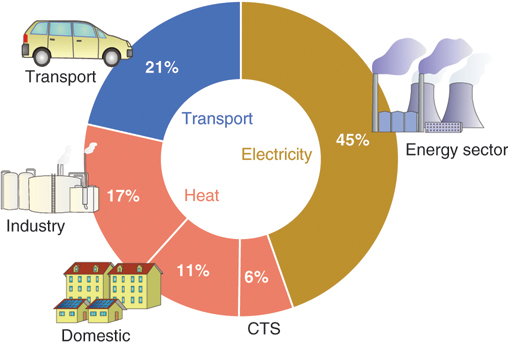
Figure 4.11 Share of different sectors in energy-related greenhouse gas emissions in Germany in 2015, CTS, commerce, trade, services.
Data: [UBA17].
 Sector Coupling
Sector Coupling
Just a few years ago, the term sector coupling was largely unknown. The term energy transition was essentially understood as the transformation of electricity supply to renewables. But for effective climate protection, greenhouse gas emissions from transport and heat supply must also be completely eliminated. In addition to the electricity sector, the heat and transport sectors must also be considered. Some authors also define the material use of fossil fuels and industrial processes as separate sectors.
Today, the heat and transport sectors are dominated by climate-damaging oil and gas. The options for using biomass or geothermal energy in Germany are technically and economically limited. Therefore, in the future a large part of the energy for these sectors will have to be covered by electricity from solar and wind power plants. The electricity sector will thus be linked to the heat and transport sectors.
However, the expansion of renewables such as PV and wind power plants must be significantly increased through sector coupling, as this will considerably increase the electricity demand. Sector coupling offers enormous opportunities for the energy transition. Surplus from solar and wind power generation no longer has to be stored exclusively in expensive electricity storage facilities. When there is a lot of sun or wind, charging of electric cars can be given preference, in order to temporarily store electricity in the car batteries for times when there is little wind or sun. In the case of heat supply, excess electricity can also be used to heat water storage tanks or raise the building temperature. This facilitates a secure energy supply, saves costs and ensures technological developments that can also be exported to other countries in the future.
4.4.2 Energy Transition in the Heat Sector
It may be difficult to cut down on electricity consumption, but substantial reductions are possible when it comes to heating. The savings options in the building sector described in Chapter 3 enable a halving of the heat demand over the next 20–30 years. It is important that policy instruments are used to strongly promote modernization measures for existing buildings and that any new-build is in the zero-energy or plus-energy categories.
In 2015, 72% of the final energy consumption for space heating and 64% for hot water was still covered by fossil fuels (Figure 4.12). Among the renewables used directly for space heating and hot water generation, biomass dominated with a 12% share of final energy consumption. The share of solar thermal energy and heat pumps was comparatively insignificant at around 1% each. Deep geothermal energy was also used, but it is statistically irrelevant.

Figure 4.12 Share of different energy sources in final energy consumption for space heating and hot water in 2015.
However, the further expansion possibilities for biomass in Germany are limited. For this reason, various renewables will ensure the supply of heat (Figure 4.13).

Figure 4.13 Components of a carbon dioxide-free renewable heat supply.
Compared to oil, natural gas performs better from an environmental and climate point of view, but natural gas is also a fossil energy source that causes considerable greenhouse gas emissions during combustion. A climate-friendly heat supply therefore requires a departure from oil and gas heating. Some countries such as Denmark have already decided to take such a step. CHP plants based on natural gas or oil are also unsuitable for a climate-friendly heat supply.
Supporters of gas heating point out that in the future natural gas can be replaced by climate-neutral gas from renewables and that natural gas only needs to be used temporarily. However, climate-neutral gas must first be produced in so-called power-to-gas (P2G) plants in the form of hydrogen and methane by using electricity from renewable power plants (Figure 4.14).

Figure 4.14 Principle of substitution of fossil-based natural gas by methane (power-to-gas, P2G) produced from renewable electricity [Qua16].
Losses in the order of 35% are to be expected. These losses occur in the form of waste heat, some of which can be used, for example, to replace fossil-based district heating. However, since P2G plants cannot run permanently, depending on the availability of electricity from PV or wind power plants, the heat supply must then be secured by thermal storage.
If the remaining fossil energy demand is to be covered exclusively by gas condensing boilers supplied by gas from P2G plants, an enormous additional electricity capacity would be required to generate the required gas quantities. Figure 4.15 shows how the electricity demand for single-family houses, which is currently in the range of 4000–5000 kWh a−1, would virtually explode if this path were chosen. The expansion of renewable power plants over a period of 20 years, which is what would be required, is totally unrealistic.
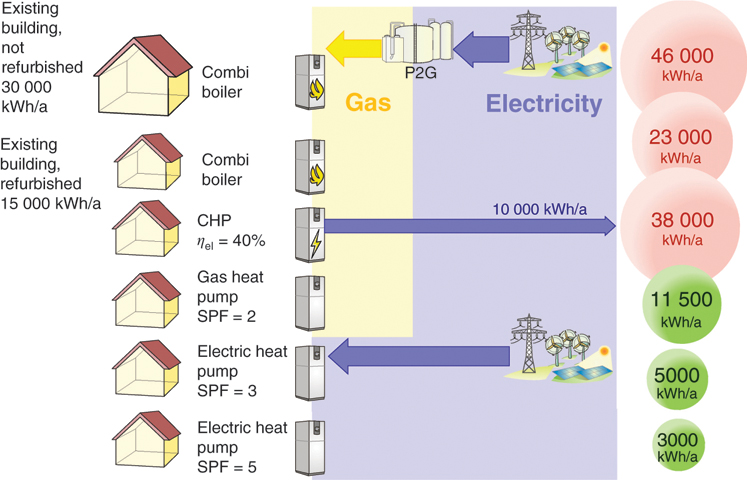
Figure 4.15 Efficiency and power consumption of electricity-based renewable heat supply systems [Qua16].
Heat pumps, on the other hand, will be able to achieve significant efficiency gains in the future. Heat pumps are electrical heating systems that use not only electrical energy but also low-temperature ambient heat. Modern heat pumps achieve seasonal performance factors (SPFs) of 3. This means that they can generate 3 kWh of heat from 1 kWh of electrical energy (see also Chapter 11). It is also conceivable to further increase the annual performance factor of heat pumps, e.g. through the use of waste heat recovery or solar thermal energy. Values of 5 can then be achieved. If heat pumps with an SPF of 5 are used and the heat demand of all buildings is halved through refurbishment, the electricity requirement for heating buildings is reduced by more than 90%.
Solar thermal systems are another option for renewable heat supply (see Chapter 6). However, these are still comparatively expensive at present. Nevertheless, it is conceivable that solar thermal energy could be integrated into local heating networks in larger units. This improves the economic efficiency considerably. If solar thermal energy is expanded more widely, the additional electricity demand in the heat sector can be reduced.
4.4.3 Energy Transition in the Transport Sector
At present, the biggest challenge is introducing climate-compatible changes in the transport sector. Here, the energy transition lags much further behind the heat sector. Only about 5% of the energy used in the transport sector in Germany comes from renewables. Most of these are biofuels such as biodiesel or ethanol, which are blended with conventional fuels. A significant increase in the proportion of biofuels is not possible because the agricultural land in Germany is not even close enough to cover the entire fuel demand with biomass fuels. In addition, part of the available biomass is required for electricity and heat generation. Biofuels should therefore be used primarily in transport sectors such as air or sea transport, where other alternatives are difficult to implement in the short term.
Other alternatives are needed for the vehicle sector. However, with broad support from German politicians, German car manufacturers have, in the past, repeatedly and faithfully resisted the implementation of climate protection measures. Some car bosses even claim that the savings being demanded would simply be physically impossible to implement. Yet, technically, modern cars are by no means energy-saving marvels. Even advanced combustion engines only achieve 25% average efficiency at best. This means at least 75% of the energy content dissipates unused, as waste heat into the environment.
Real efficiency gains can only be achieved by the electric motor, which easily achieves efficiencies of well over 80%. Figure 4.16 compares the efficiency of cars based on the range per kilowatt hour. A petrol-powered car with a fuel consumption of just over 7 l per 100 km, which corresponds to 65 kWh per 100 km, can only travel around 1.5 km with 1 kWh. If petrol is replaced by fuels such as hydrogen, methane, or methanol based on renewables, the range is reduced to 1 km kWh−1 due to the losses in the production of renewable fuels. If an efficient electric car is used instead of a car with an internal combustion engine, the range doubles. However, the electric motor cannot fully develop its potential because the fuel cells in the car first have to convert the renewable fuel back into electrical energy, which also results in losses. That is why a battery-powered electric car has the longest range. It eliminates losses during fuel production and reconversion to electricity. The losses during charging and discharging of the battery are comparatively low.
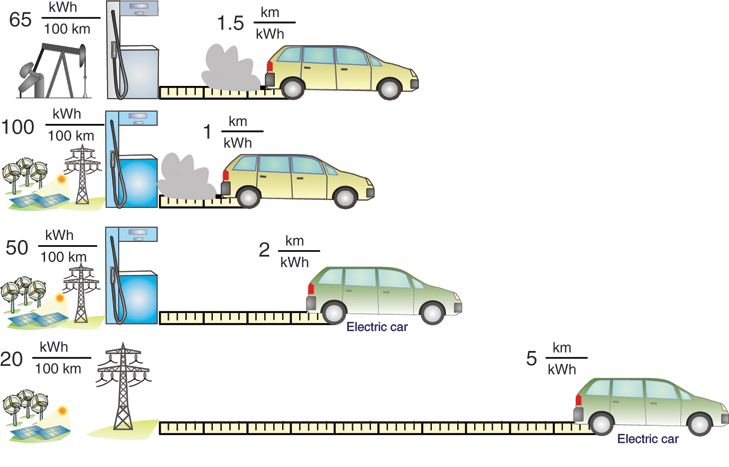
Figure 4.16 Comparison of the efficiency of different drive concepts for passenger cars.
The example shows quite clearly that a successful energy transition requires a consistent switch to electric cars. Thanks to technical innovations and massive cost reductions for vehicle batteries, battery-operated vehicles can already easily replace combustion engines in passenger cars and local goods transport. When longer ranges are required, a fuel cell vehicle using hydrogen from renewables can be an alternative. In long-distance freight transport, where long ranges are important, wire-bound electric trucks can replace the internal combustion engine. Such trucks have already been developed and are currently undergoing practical testing. The trucks are equipped with a hybrid drive and automatically latch onto an overhead line, when available. For large-scale operation it would make sense to electrify the inside lane of most motorways. Costs of around one million euros per kilometre are expected (Figure 4.17).
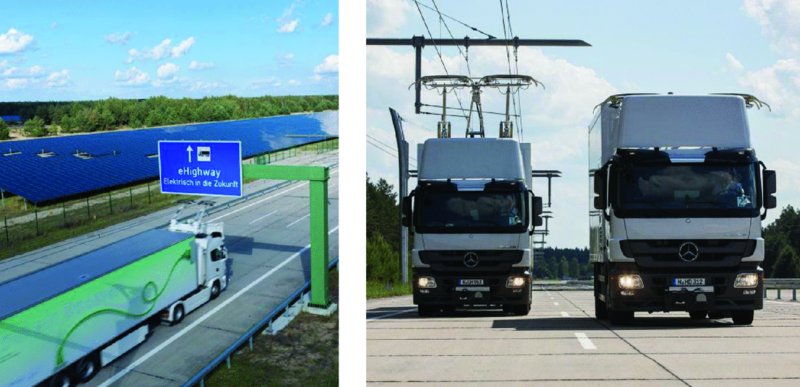
Figure 4.17 Electrified motorway with wire-bound electric truck.
Source: Siemens, www.siemens.com/ presse.
If we consistently focus on traffic avoidance, this would be of great help in implementing the energy transition in the transport sector. Therefore, public transport and the use of bicycles and footpaths should be significantly enhanced. For goods, an increased use of regional products is desirable. And if we succeed in bringing work, domestic, and leisure activities closer together in terms of space, traffic routes will also be reduced, and the quality of life will be improved.
4.4.4 Energy Transition in the Electricity Sector
In contrast to the heat and transport sectors, the transformation to a renewable electricity supply system has already started successfully. In 1990 hydropower, with its share of around 3%, was the only renewable energy source worth mentioning. Over the next 20 years this was followed by wind power, biomass use and, more recently, PV. Their combined share was 17% in 2010, and by 2016 they had already reached 32%. However, carbon dioxide emissions did not fall by the same amount over the same period. While electricity was still imported into Germany in 2002, exports have increased enormously since then with declining electricity generation from nuclear power, which means that the share of coal-fired power generation has remained high.
If the use of oil and natural gas in the heat and transport sectors is also to be completely eliminated, electricity demand will increase significantly. Plus, there is the additional electricity consumption for a carbon-dioxide-free transformation of industry. If the electricity is then covered exclusively by renewables, it will mainly be based on fluctuating generators. To ensure a constant availability of the energy supply throughout the year, large storage capacities are required, consisting of battery and gas storage. This results in relatively large conversion and storage losses in the order of 20%. Figure 4.18 shows how this would increase electricity consumption.

Figure 4.18 Increase in electricity demand if a climate-friendly energy supply is reached by 2040, taking into account sector coupling.
In the future, electricity supply in Germany will become much more interesting and versatile. While it is virtually impossible to open up new potential for hydropower in Germany, wind power and PV have the greatest potential for expansion. In theory, both wind power and PV on their own could each cover the entire electricity demand in Germany. In practice, however, this does not make much sense, because large and expensive storage would be necessary due to the fluctuating availability of wind energy and solar radiation over the course of the year. However, a sensible combination of different renewables significantly reduces storage requirements. Due to their great potential, PV and wind power will cover the majority of the annual demand in the future. However, the construction of new PV and wind power plants will have to increase significantly in the coming years (Figure 4.19).

Figure 4.19 Possible expansion paths for renewables to reach a climate-neutral electricity supply.
Controllable renewable power facilities such as geothermal plants or biomass power plants can only cover a small part of the supply in situations when the supply of wind and solar energy become simultaneously scarce. An intelligent control system must make sensible use of the various generators.
It is also conceivable that consumers could be switched on and off as required as part of smart grid concepts. Refrigerators, electric heat pumps or charging stations for electric cars could purchase more electricity from the grid than usual if there was a surplus of wind and solar energy. In the case of the refrigerator, the temperature would then drop slightly, in the case of the heating it would rise slightly, and in the case of electric cars the battery would be fully charged. If the supply subsequently falls again, these devices could curb their demand and then return to normal.
Further components of a sustainable electricity supply include balancing of the grid at a national level and import of renewable electricity. Despite all these measures, the storage requirements for a purely renewable electricity supply will rise sharply due to the large fluctuations in the supply of solar and wind energy. Batteries or pumped storage power Wplants are suitable for short-term storage. Hydrogen or renewably produced methane is an interesting energy source for storage over longer periods of time. The quantities required for this are relatively small compared to the possible demand in the heat or transport sector, and the associated losses are justifiable (Figure 4.20).

Figure 4.20 Components of a carbon dioxide-free renewable heat supply.
Fossil power plants and nuclear power plants are no longer necessary for a secure and climate-friendly electricity supply by the year 2040 at the latest and become an obstacle even before then. With the exception of gas-fired power plants, they cannot act as a bridge, as is often claimed. Lignite and nuclear power plants, in particular, are difficult to control and hinder smart operation in grids with high supply fluctuations. Gas-fired power plants, on the other hand, are much more responsive. Fossil-based, climate-damaging natural gas can ultimately be gradually replaced by biogas and renewably produced hydrogen or methane.
4.4.5 Reliable Supply Using Renewables
In purely arithmetical terms, renewables can thus cover the entire annual average energy demand. However, many people still question how electricity supply can be guaranteed – for example, if there is no wind blowing after the sun goes down. In this case, the output from PV and 78778 power plants would be zero. It is difficult to imagine that this would not cause massive problems.
With a balanced mix of different renewable power plants, which are intelligently linked through a central control system, the power supply can also be ensured in the case of highly fluctuating renewables (Figure 4.21). To prove this, various companies from the renewable energy sector initiated a Combined Power Plant project in 2007.

Figure 4.21 Principle of a controlled combined cycle power plant for a reliable renewable power supply.
![]()
Information on the Combined Power Plant project ‘Germany has unending energy’ campaign |
This Combined Power Plant linked and controlled 36 wind, solar, biomass and hydroelectric power plants scattered all over Germany. It covered exactly one ten thousandth of the whole German electricity demand. A central control system received information on the load profile and current weather forecasts. At times when wind and solar plants did not generate enough electricity, other plants had to step in. In the case of the Combined Power Plant, these were biogas plants and a pumped-storage hydropower plant. As biogas is easily stored, electricity can be generated at any time. Surplus supplies can then be stored temporarily in pumped-storage facilities or used to charge batteries for electric cars. There were very few instances when the wind and solar energy plants had to be cut back due to long sunny and windy periods. During these times a small proportion of the surplus was lost.
The results of the Combined Power Plant project were very promising. It turned out that on a small scale the demand could be covered almost optimally (Figure 4.22). The desired reliability of the electricity supply was achieved. So, there is no convincing reason why in the near future the entire energy supply cannot be completely covered by renewable energies in a similar way.

Figure 4.22 Shares of various renewable power plants in meeting energy requirements during a summer week in the Combined Power Plant project.
Source: kombikraftwerk, www.kombikraftwerk.de.
However, the storage requirements of a purely renewable electricity supply are several orders of magnitude higher than the capacities available today. At present, pumped-storage hydropower plants are mainly used for storage (see Chapter 9). However, the possibilities for constructing new pumped storage power plants in Germany are very limited. Therefore, the use of hydropower storage capacities in Norway or the Alpine countries is under discussion. Theoretically, there is much greater potential there than in Germany. However, the accessible capacities will also be significantly below the required storage requirements. The laying of the necessary power lines alone would cause major issues. High-voltage power lines across ‘postcard fjords’ are not very popular in Norway either.
New battery storage in PV systems or in electric cars could also contribute to meeting storage needs. However, even these capacities will not be sufficient for a secure, purely renewable electricity supply. Since, for effective climate protection, the extensive storage potential would have to be fully established within 30 years at the latest and only technologies that are quickly available on a large scale could be used.
The solution is seen in the natural gas network. Germany already has a very dense natural gas network with enormous underground storage facilities that can secure energy supplies for weeks. These networks and storage facilities can be used directly for the future electricity supply. The existing storage potential is already sufficient today to largely cover future demand.
Electrolysis (see Chapter 13) could produce hydrogen in the future from excess electricity at times when solar and wind output is high. Smaller quantities of hydrogen can be stored directly in the natural gas network. Up to a share of 5%, hydrogen can replace natural gas relatively easily. Shares of up to 20% are considered possible [Hüt10] (Figure 4.23).
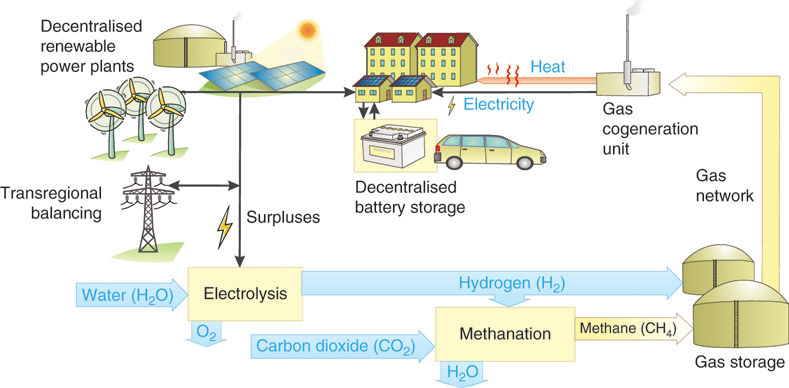
Figure 4.23 Use of the natural gas network to meet the storage needs of a purely renewable electricity supply.
Biogas can also be fed into the natural gas grid. If even higher hydrogen contents are to be achieved later, either the consumers can be converted to pure hydrogen operation or the hydrogen can be converted into renewable methane via methanation plants. The renewable methane could then directly replace fossil-based natural gas without further conversions. At times when there is little wind and solar energy available, the renewable hydrogen or methane is then fed back into the grid via cogeneration plants or fuel cells, which can also provide heat in addition to climate-friendly electricity.
4.4.6 Decentralized Instead of Centralized – Fewer Power Lines
‘The construction of numerous new high-voltage lines is the central problem of the energy transition’; such statements proffer a message that is often repeated like a prayer wheel. However, the answer to the question of power line requirements is not entirely simple. In Radio Yerevan style it would be: In principle, power lines are helpful for the energy transition. But it depends on the structure that is envisaged for our renewable energy supply in the future. Maybe we don't actually need that many power lines.
A general distinction is made between distribution networks and transmission grids. The distribution networks transport the electricity to the end customers. In Germany, the distribution networks are often operated by regional utilities such as municipal utilities. There are now over 900 distribution network operators in Germany. The distribution network must be continuously expanded in order to be able to cope with electricity from new decentralized wind power and PV systems. In order to be able to charge a large number of electric cars in the future, the distribution networks must also be expanded. The replacement of local network transformers or the selective reinforcement of some existing lines is often sufficient for this purpose. In local networks, the lines are often underground, so that line reinforcement usually has a high level of acceptance among the population.
The situation is different for transmission grids. They consist of extra-high voltage lines, the so-called electricity highways, which transport electricity over long distances (Figure 4.24). These are usually large overhead lines, which often meet with little approval from local residents. For a strong expansion of offshore wind energy use at sea or the construction of large capacities of wind and solar power plants in sparsely populated regions, these lines must be strengthened, as their electricity cannot be consumed locally. The continued operation of inflexible lignite or nuclear power plants also increases power line demand. If conventional power plants continue to operate at times of high solar and wind supply because they are difficult to control, there will be regional surpluses that will have to be removed via the extra-high voltage lines. At times of high solar or wind supply, Germany now regularly exports large quantities of electricity abroad.

Figure 4.24 High-voltage lines are among the most controversial elements of the energy transition. In the long term, they are needed for the connection of offshore windfarms, for example. In the short term, they are mainly used for the distribution of surplus electricity from poorly controllable conventional power plants.
A power supply based entirely on renewables will not function without the use of offshore wind energy and thus without new transmission grids. However, the decentralized expansion of solar and wind power is much more important for a fast and cost-effective energy transition. If solar and wind power plants were first installed regionally where the electricity is also consumed, the expansion of the transmission grids could be significantly reduced. In a decentralized supply structure, gas-based storage facilities and rapidly controllable reserve power plants have a higher priority. They can quickly replace coal-fired and nuclear power plants with renewables.
4.5 Not So Expensive – The Myth of Unaffordability
The central message from politicians and energy companies that a rapid energy transition is unaffordable seems to have been their mantra in recent years and it is true that electricity prices more than doubled between 2000 and 2017. Figure 4.25 shows the development of electricity costs in Germany, which comprise the generation of conventional electricity and distribution, taxes and duties as well as the so-called EEG (Erneuerbare-Energien-Gesetz) levy. The EEG levy covers the additional costs of generating from renewables compared to conventional power plants, and is charged to households and smaller commercial customers. It has fallen into disrepute as the cause of the electricity price increases. But even if we completely abolished the EEG levy, electricity prices would still have risen by a substantial 60% between 2000 and 2017.
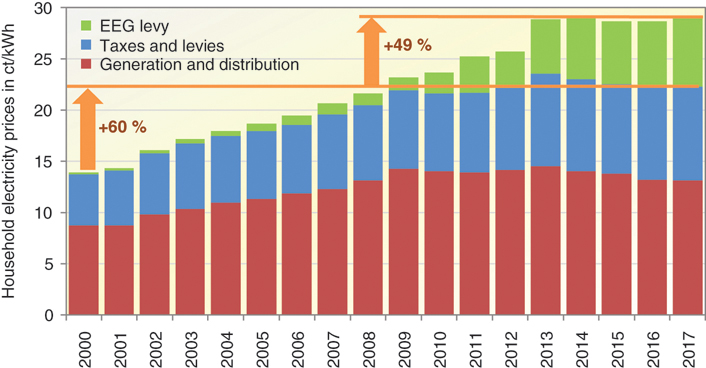
Figure 4.25 Development and composition of household electricity prices in Germany.
The EEG levy is actually higher than it has to be. Many industrial companies are exempt from the levy. Plus, the increasing capacities of renewable power plants are decreasing prices on the electricity exchanges. This is good for industrial customers who purchase cheap electricity directly on the stock exchange. Household customers, on the other hand, do not like these price reductions. Since the EEG levy is calculated from the additional costs of renewables compared to the stock exchange electricity price, falling stock exchange electricity prices result in a higher EEG levy and thus higher household electricity prices.
Falling coal prices are a disaster for achieving climate protection targets. The CO2 certificate trading should actually increase the price of electricity from climate-damaging power plants and thus lead to a reduction in demand and hence emissions. However, the economic crisis in Europe, far too generous allocation of allowances and the rapid expansion of renewables have led to an enormous oversupply of allowances and thus to a dramatic drop in prices. However, the consequential costs of unbridled carbon dioxide emissions will also have to be paid in the future. There are no reserves for this. The Federal Environment Agency puts the actual consequential costs of climate change at €80 t−1 of carbon dioxide [UBA14]. At the beginning of 2018, the price of CO2 certificates was around €8 t−1 of carbon dioxide. In Germany alone, the unallocated consequential climate costs thus correspond to a subsidy of well over 20 billion euros for fossil power plants.
A study by the Fraunhofer Institute for Solar Energy Systems clearly shows that a completely renewable energy system will not be more expensive than the current supply system [ISE12]. However, this only applies to the final expansion phase. The investments for the transformation inevitably lead to higher costs during the transition period. This is not really surprising. Electricity prices also had to be increased when nuclear energy was introduced. While the prices for renewables are falling continuously, the overall trend for fossil fuel prices, despite some ups and downs, is up. The prices for heating oil roughly tripled between 2000 and 2013. In the same period, the price of solar power fell to a quarter (Figure 4.26). And this trend is continuing. Even today, renewables are already competitive in many areas of the world, without subsidies, compared to new conventional power plants. The countries that first decoupled from oil, coal, natural gas, and uranium and their associated price increases will therefore also benefit significantly financially.

Figure 4.26 Development of prices for household electricity, heating oil, petrol, generation of PV electricity and wind power in Germany.
4.6 Energy Revolution Instead of Half-Hearted Energy Transition
4.6.1 German Energy Policy – In the Shadow of Corporations
A major obstacle to a rapid and climate-friendly transformation of our energy supply is the close intertwining of energy and automotive companies and politics. Before or after their active careers, many politicians held high positions in energy and automotive companies or worked as consultants. As a result, the energy transition is always designed with the interests of corporations at the forefront, which have placed great emphasis on fossil fuels as well as petrol and diesel vehicles. Effective climate protection and the interests of the population are often put at the bottom of the list.
Due to this intertwining, more and more contradictory decisions are made, which make a quick and meaningful energy transition more difficult and cause unnecessary additional costs. Figure 4.27 clearly shows that in 27 years no federal government in Germany has succeeded in reducing the share of fossil power plants in electricity generation. Initially, the increase in electricity generation from renewables compensated for the decline in nuclear power plant electricity and the increase in electricity consumption. Electricity exports were then noticeably increased. In 2017, German power plants were already able to cover three quarters of Austria's electricity demand in purely arithmetical terms.

Figure 4.27 Development of gross electricity generation in Germany and electricity exports. Despite the energy transition, the proportion of fossil-based power plants remains largely constant.
Data: [AGEB12].
Although there have also been low carbon dioxide savings in recent years, due to increases in the efficiency of fossil-based power plants, reductions of a completely different magnitude are, however, required for effective climate protection. This can only be achieved through a rapid reduction in the proportion of fossil-based power plants and a significantly faster expansion of renewables. Instead, the expansion of PV systems in Germany was reduced from 7.6 GW in 2012 to 1.5 GW in 2016, resulting in the loss of around 80 000 jobs in the PV sector. A significant reduction in wind energy expansion was then initiated for 2019, even though Germany has thus lost all chances of achieving the climate protection targets it had set itself for 2020. The only discernible goal of the political restrictions on supplies was to prevent a sharp drop in fossil-based power generation.
4.6.2 Energy Transition in the Hands of the Citizens – A Revolution Is Imminent
Politicians and energy companies are at best very cautious in supporting the energy transition. The driving force is the population itself. Over 40% of the 100 GW of renewable electricity generation plants in 2017 belonged to private individuals and farmers.
Only 5.4% were owned by the four major energy supply companies (Figure 4.28). As a result, they have noticeably lost influence and market share in recent years. With their influence on politics, they have played a major role in slowing down the energy transition in Germany. They have tried to adapt to the new market environment with restructuring measures. However, due to the large number of conventional power plants still in operation, they are only able to make slow adjustments.
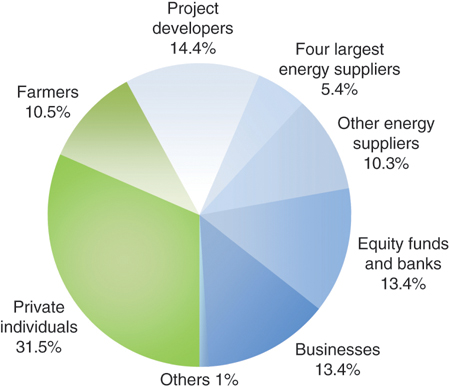
Figure 4.28 Distribution of the ownership of the renewable energy plants that provide Germany's electricity.
Data: AEE/trend research, 2017.
But not to worry; as in the past, many other players will continue to drive forward the energy transition in the future. This means that the democratization of our energy supply is in full swing. A real energy transition is emerging where energy companies will play an ever decreasing role. Everyone can participate in the energy transition by investing in renewables. Those who do not have their own roof for the construction of a solar plant can participate in one of the numerous new operating companies or energy cooperatives and thus also benefit from the energy transition. In future, profits will no longer be limited to large energy companies. This means that it is in our own hands to quickly create a sustainable energy supply, so that we can also preserve the lives of future generations. It is up to us now.
